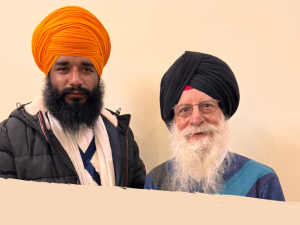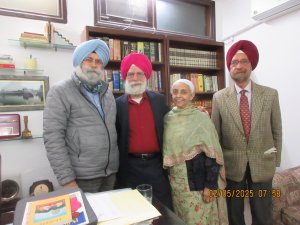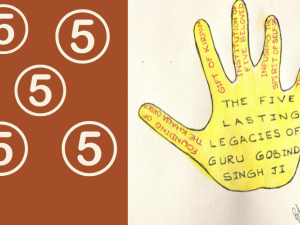Many a times when I read Gurbani, I wonder about the situation, circumstances and place the very words I am reading, were uttered by Guru Sahib. Even when we do find such a historical evidence, we come out empty handed as those evidences have not been either recorded, preserved, or many of those locations have limited functionality and accessibility as they are now "Evacuee Property" in Pakistan. But, when I heard about the place where Guru Gobind Singh Ji composed the Bani of Chaupai Sahib, I always wanted to visit the place known Vibhaur Sahib. I was blessed with the opportunity to visit this auspicious place, 18 kilometers from Anandpur Sahib on 24 October 2016. This place besides being auspicious as Guru Ji stepped on it, thus having Guru Ji's "Charan choh" also has an added significance as the bani of Chaupai Sahib was composed by Guru Ji during his stay here. While returning back to Anandpur after the battle of Bhagani, Guru Ji spent few months here.
The composition starts as a supplication that asks for blessings and protection from God. Then Guru Ji prays that may all my desires be fulfilled, and obtain God's Love and Mediation. The heart's desire is that my heart may be at your feet, and you nurture me as your own. This bani is truly significant as it is part of our daily prayer and also part of banis recited during preparation of Amrit. This bani is a supplication to Almighty, yet one can feel that Guru Ji is having heart to heart conversation with God. The words coming out of Guru Ji's mouth are a word portrait of state of his mind. Now, if we can add the natural environment and the surrounding ambience that spawned that state of mind, it takes us into ecstasy. Fortunately for us we can go there and touch the rocks, hills, leaves, trees on the banks of river Sutlej, that have the privilege of being the environment that created that unique composition. Additionally by going there we can also breathe that same mountain air that gave birth to Chaupai Sahib and it still permeates in that air.

The natural beauty, the mountain air, the undulating hills and valleys makes the jaw drop in awe and wonder. The spell binding natural beauty calms the mind, soothes the nerves. Only one question kept popping in my head, where is the spot Guru Ji sat on and wrote this magnificent composition? How was the weather that Sunday (as detailed by Guru Ji) like, when these words of prayers poured out by Guru Ji like the flowing Sutluj. Imagine the meditative pose of Guru Ji, the cool breeze blowing, the leaves fluttering and with a pen in hand Guru Ji is having a conversation with God. Then, Guru Ji concluded the composition with these words "All this I write with your blessing. This is not what I know but what you have shown me." The curiosity and inquisitiveness to witness the serenity of the spot turned into disappointment, when I discovered that the special spot has been dazed to ground in the name of befitting memorial. So, in the name of creation of a memorial the serenity, auspiciousness, natural beauty, historical land marker has been destroyed and replaced with brick, cement, concrete and marble edifice.
CHAUPAI
ਸੰਬਤ ਸੱਤ੍ਰਹ ਸਹਸ ਭਣਿੱਜੈ ॥ ਅਰਧ ਸਹਸ ਫੁਨਿ ਤੀਨਿ ਕਹਿੱਜੈ ॥
ਭਾਦ੍ਰਵ ਸੁਦੀ ਅਸ਼ਟਮੀ ਰਵਿ ਵਾਰਾ ॥ ਤੀਰ ਸਤੁੱਦ੍ਰਵ ਗ੍ਰੰਥ ਸੁਧਾਰਾ ॥੪੦੫॥
Sambat satrh sahis bheNije. ardh sahis phun teen kaheje.
Bhadrrav sudee ashtmee ravivaraa. Teer sat-drav granth sudaahraa. (29)
MEANING:
It was Bikrami Samvat 1753 (September 14, 1696); This book was completed
on the banks of Sutlej on Sunday, the eighth Sudi of the month of Bhaadro.
Most Gurudwara buildings look-alike, in terms of architectural concept, facade and appearance. While the efforts of organizations and individuals spearheading the efforts to build a fitting memorial in the midst of mountains are really appreciated, but it pains my heart to say that we have robbed history from our future generation. Where a visit could turn back the time, taking us to the times of Guru Sahib, has now become a visit to one more Gurudwara, a look alike but with a historical association. The pain was deeply felt in the heart as to why are we robbing ourselves of our own history? Just the thought of us robbing our own future generation brought the tears down my cheek. We cannot blame anybody else for the permanent loss that we are creating, in the name of a marble and gold edifice. We as a community have a collective failure in preserving and nurturing our history. We have failed our future generations. The piece of history that could inspire generations, fire the flames of faith has now become just another Gurudwara building. Sometimes the structural integrity of the original may be in jeopardy or the structure may be in a severely ruined that the original cannot be salvaged. In such a situation an exact replica using suitable construction material and the building techniques of the times can be employed, thus history preserved.

If we look at the deeds of Gurus, we can see that they not only preserved their own bani, but also compiled it in a fashion that it cannot be altered and is preserved for ever. Yet, we as the followers of the Gurus cannot even preserve the spots where it was created. Our Gurus are builders of cities, townships, communities, and we cannot even preserve the spots associated with our Gurus. Are we really followers of our Gurus? Our Gurus have uttered bani in different situations, different place and addressed varied issues/subjects. Alas, we hardly have any historical evidence of the place and the context in which the particular bani was uttered.
The painful part is wherever we have a solid historical evidence of situation and place the bani was uttered, we have tempered and destroyed that legacy and evidence. Our history is only 550 years old, yet we have failed to preserve it. Every place associated with a confirmed historical setting has been decimated and replaced with Gurudwara building of marble and gold. It is undoubtedly a reflection of reverence, faith and desire to preserve the legacy. Yet when we visit these places, we feel the vacuum created by the loss of historical evidence and legacy. Most of these edifices are lacking the touch of local construction material of the times that was part of the historical legacy. Today, we can visit these historical places but the memorials are relatively a new construction and they do not convey the historical relevance or share the history with us. The marble and gold that are enshrined there, have taken over the historical evidence. The plants, trees, soil, rocks and the topography that witnessed the history, are not there anymore. These may not talk, yet they can convey a lot to the pilgrims and tourists, which has now been deprived. As the experience that they absorbed then, if kept alive would have been conveyed to us portrait of those times. That transmission of the portraits would have enriched our experience there and would have nurtured our commitment and growth. Alas! We have inflicted upon ourselves enough damage in terms of lost historical legacy and destroyed relics which can't be replaced.
It is truly a sad commentary on the psyche of the Sikhs, who have failed to preserve the history associated with their Gurus. We can start from the birth place of our first Guru in Nanakana Sahib to the resting place of tenth Guru in Nanded and we cannot find any historical relics left. We can extend further the sad legacy to include the four Sahibzades of Guru Gobind Singh.
The others will always try to rob us of our legacy, but when we have also contributed and have made part of lost legacy, whom should be blame? Sadly! We do not have anybody else to blame. It is time for us to wake up and change our psyche and approach on modernization and preservation of historical places. May be we need to take our custodians of Gurudwara construction to visit some historical cities like Rome to make it an eye-opening experience on how the legacy is preserved. Let us not destroy the historical evidence and geographical flavor in the name of befitting memorial. There is room for both to co-exist, where the preservation and modernization can complement each other. The befitting memorial is welcome addition but it should not be over decimated historical evidence.
Moving forward when we create a befitting memorial, there the central piece and attraction should be the historical. There are many museums around the world where the settings are modern yet the history has been preserved or recreated as an exact replica of the times. The flavor of the times has been recaptured for enriching our experience of the visit to the place. Let us change our approach and become preserver of history and not those who over saw the destruction of historical evidence. It is about time to change our roles from those who oversaw tearing down of history, to those who preserved the history.





